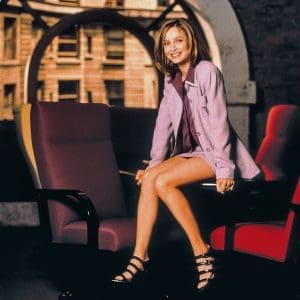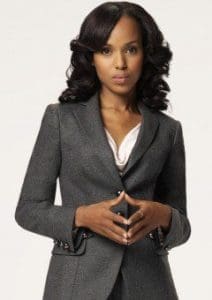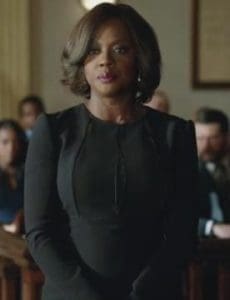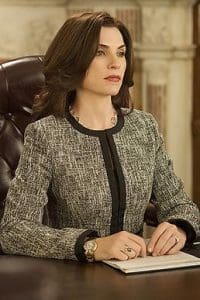Former Obelisk Support interns Maxie Chopard and Keshara Hallock take us through the portrayals of women lawyers on TV and how characters have grown and developed over time. They discuss the power of representation in popular culture in shaping societal expectations and gender stereotypes.

One of the earliest portrayals of a woman lawyer on American television was Mary Bancroft (played by Elsie Ferguson) in Scarlet Pages in the 1930s. The all-talking crime drama features Bancroft as a successful female lawyer in New York who acts as defense attorney for Nora Mason, a nightclub singer accused of murder. The twist in the plot comes when Bancroft subsequently discovers that Mason is the biological daughter she had given up for adoption.
Interest in female characters in the legal profession seems to have increased in the last decade. Alicia Florrick (Julianna Margulies) in The Good Wife, Olivia Pope (Kerry Washington) in Scandal, Annalise Keating (Viola Davis) in How to Get Away with Murder and Jessica Pearson (Gina Torres) in Suits, are just a few household names whose on-screen lives we have become fully vested in.
Has the Portrayal of Women Lawyers on TV Changed?
One might be tempted to argue that the depiction of women lawyers on television has not evolved as quickly as one would like. Scarlet Pages capitalised on the novelty of a woman occupying a powerful position in a typically male-dominated industry. That Bancroft was a lawyer in Scarlet Pages was a fact that was referenced. She was never shown as doing anything particularly “lawyerly.”
The Ally McBeal Effect: Drama over Substance?

More than half a century later, Ally McBeal was all about the drama that ensues when the character portrayed by Calista Flockhart finds herself caught in a love triangle after joining a firm where her ex-boyfriend and his current wife also work. Once again, the focus is not on the woman lawyer acting in a professional capacity but the unfolding of her personal story.
Indeed, the juicy details of the leading women in law often seem to dominate the plot. Former lawyer and White House aide Pope’s affair with United States President Fitzgerald Grant (Tony Goldwyn) is a central pillar of Scandal. Defence Attorney and Law Professor Annalise Keating’s affairs, multiple relationships and closet full of secrets have fuelled four seasons of How to Get Away with Murder.

Equality requires Complexity
At the same time, it is fair to say that women in law are increasingly being portrayed as more complex and nuanced characters. In How to Get Away with Murder, the mercurial, highly intelligent and unscrupulous Keating is fearsome, yet there are times when she appears vulnerable. Similarly, Pope’s groundbreaking role in Scandal has been described by The New York Times as, “possibly the most complex black female lead in television history.”
The marked shift from characters such as the perpetually self-questioning McBeal to the emotionally strong, professionally powerful, and personally complicated women in law on television we see today has been accompanied by a greater emphasis on women as competent professionals.

It is no longer uncommon to see a strong, confident woman litigator who beats men on her own terms. The no-nonsense, straight-talking Pearson in Suits comes to mind, as does How to Get Away with Murder’s Keating, who is often seen browbeating witnesses, opposing counsel and indeed anyone who stands in her path into submission. Founder and managing editor of Above the Law David Lated coined the term “the litigatrix” to represent such women who tend to more demanding than their male counterparts, to the extent of being pushy and domineering.
Empowering… or Emaciating?
The prevalence of women lawyers on television can be seen as empowering, particularly as they are often shown to be breaking the glass ceiling. Pearson, for instance, is the first African-American woman to work as a judicial clerk at the Third Circuit Court of Appeals and later becomes partner of her firm after leading a successful coup against the name partners.
As a powerful socialiser, the media makes its marks on both self-image and societal expectations. Professor Ric Sheffield who teaches Law and Society Kenyon College observed that starting from the 1980s, his 19-22 year old students seemed to have an acute understanding of what it meant to be a lawyer even though they had not been to law school. The students did not know famous U.S. female judges such as Ruth Bader Ginsberg, Elena Kagan or Sonia Sotomayor but knew Pope from Scandal. It was clear that his students had gleaned this knowledge from pop culture.
Portrayals of women lawyers on television could inspire and encourage girls to join the profession. However, not everyone is of the view that these characters are positive role models. Others argue that these female characters are detrimental, as they entrench gender stereotypes and normalise the disparity between men and women in the legal profession.
Shaping Fiction to Shape Reality

Are the women in law in the media a source of empowerment or disenfranchisement? What do you think? The jury is still out for us on this one overall…
That said, it is important to acknowledge just how far portrayals have come, and one particularly good example is Jessica Pearson of Suits, the Managing Partner of Pearson Specter Litt. Gina Torres, who plays Pearson reveals that for her, the character’s strength comes from the fact that “her drive and her ambition has nothing to do with her gender or cultural background”. Torres is right; Pearson’s role is equatable with her position at the firm. Her leadership, intellect and the respect she garners from her colleagues are all in keeping with the person at the helm of the firm irrespective of their race, gender or anything else. The portrayal is thus at one level reassuring, demonstrating a woman judged on skill, who has thrived in a meritocracy.
“Jessica was conceived as a man” – Gina Torres
Some might say Pearson’s presentation is not progressive in portraying women in positions of power. She is tough, straight-talking and physically domineering, towering over other characters, men included. Does she in fact reinforce the stereotype that it still in really is a man’s world and the only way a woman can be successful is to assimilate?We would disagree with this. Pearson is not void of femininity – yes, she casts a powerful figure and is business-like but this is hardly surprising; she is managing a corporation. Furthermore, Pearson is undeniably elegant. Her deportment and costume choices are symbols of grace as much as of self-assurance.
Work-Life What?
Aspects of her presentation, however, do make us question the industry’s accommodation of women or anyone who aspires to anything beyond their life at a powerhouse firm. Pearson’s life is the firm and this is not because she has to try that much harder to prove herself. It is the same for the male characters working at a senior level too. The show reinforces the idea that work-life balance is seemingly unattainable when at the top of the industry. Somewhat disturbingly however, we are not often made to feel as though anything is lacking.
It is hard not to notice that the workplace becomes the forum for all other activity. Characters constantly refer to each other as their ‘family’ and the most successful relationships are between co-workers, which seems to be a curious attempt to compensate for the fact that maintaining a life outside the firm is near impossible for them to achieve.

Non-Linear Depictions
The Good Wife is in this respect of greater significance for women in its depiction of the more modern struggle to merge career success and life or family. Alicia Florrick is as inspiring a lawyer as Jessica Pearson; she is quick, sharp and respected for being very good at what she does. However, and the clue really is in the name, she is a wife and a mother and the domestic space features as heavily in the show as the workplace. There are no illusions and the roles are quite realistically in conflict at times but in terms of female empowerment, this is still a positive step. It is more important for it to be shown that there are career-minded mothers than to depict only mothers or career women because we are uncomfortable with not having found a fool-proof equilibrium between the two yet.
Moving with The Times
The fact that the programme is not afraid to illustrate changing ambitions and priorities is also beneficial; Florrick is a Georgetown Law attendee, who leaves the profession to raise a family but a decade later wants back in. This may be because she has a monetary need but quite quickly she comes to value professional stimulation as much as she does being a mother. It is positive that this shift is shown without judgment and furthermore that after an adjustment period, it is proven that she is more than capable of performing at this level in spite of time away.
The Future is Yours. No, Really…
Finally, the way that Florrick’s relationship with the firm fluctuates, charting her desire to start her own firm and eventual return to the firm on new terms is powerful in expressing more modern values and mentality towards career progression. Her journey illustrates the increased importance of a feeling of autonomy even when working within a corporation and compares nicely to her senior, Diane Lockhart, who spent her life devoted to the firm she is now in charge of. Showcasing a woman who is unapologetic in shaping her career path proactively according to what she wants and not within the constraints of where she is granted to go by another is refreshing. The audience does not always approve of her decisions nor are they always fruitful but nevertheless her fearlessness is surely a powerful lesson for the next generation of women.
TV writers are clearly increasingly realising and exploiting the potential of female lawyer characters. Solidifying the image of success women lawyers on TV is an important step towards reinforcing this as a working norm for future lawyers of both genders. If television can help spark conversations of how the profession makes this work for women in reality as they advance in their careers, surely this is a bonus.
Next on the agenda ought to be getting British writers on board. Whilst we do seem to have a penchant for the female detective, female lawyers are decidedly few compared to U.S. TV series, but perhaps that discussion is for another article!